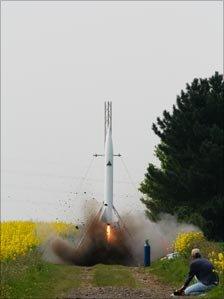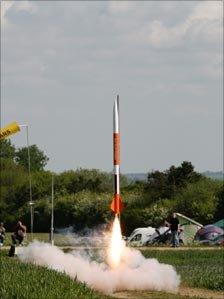Tech Know: The sky is not the limit
- Published
Ellie Gibson meets the inventors who fire 20-foot tall rockets into the skies above Cambridgeshire
In our regular series about makers and hackers, BBC News meets the rocket men.
Rain is the mortal enemy of the amateur rocketeer.
That regard for the weather is one of the many things setting rocketeers apart from makers, hackers and other hi-tech hobbyists who typically practise their pastime indoors.

A sight to stiffen the sinews of any red-blooded geek
It is not just dampness that causes the problem, though that can short out delicate electronics and make rocket engines go phut instead of whoosh.
To begin with, the low cloud might conceal an aircraft that did not read the warning notice rocketeers must lodge every time they fly.
Also, the atmospheric conditions preceding a shower or storm can scupper a launch before a single raindrop falls from the heavens.
One of the rarer ways that the weather can catch out a rocketeer was witnessed during the most recent two-day launch festival run by the East Anglian Rocketry Society - an event known as Big Ears.
The society uses the fields of a farmer close to the village of Elsworth in Cambridgeshire. These have the advantage of being flat, which aids rocket recovery, and far enough from habitation to limit the risks for man, beast or home.
At the Big Ears gathering, veteran rocketeer Rod Stevenson had his I Class, four-foot tall, two-stage rocket on the launch stand, and was walking back to the control point where he would connect the wires to trigger its engine and launch it.
Suddenly, boom, a black powder charge in the rocket went off. As it was meant to do, the explosion popped off the nose cone and pulled the parachute open. Perfect. All to no good as the craft still sat serene on the pad.
An inspection showed the altimeter inside the rocket registering a height of 852 feet - hence it firing the charge. The cause was not the rocket reaching its apogee but, he speculated, a change in air pressure caused by a storm front moving in.
Subsequent investigation showed, said Mr Stevenson, that all the electronics checked out fine. He blamed the misfire on a "freak accident".
On the day, strolling back to the preparation area as the rain began to fall with the rocket across his shoulder, Mr Stevenson looked up at the gathering clouds and remarked: "Every day is a new day in rocketry."
That, perhaps, explains some of its attraction.
It is, like many other hi-tech hobbies, easy to get started with but hard to master.
Boom or thrust

Rocketeers need to be competent craftsmen
It's likely that fans of the home-made and the hi-tech took their first steps in rocketry as youngsters. Perhaps they made rockets by sticking fins and a foam nosecone on to a plastic pop bottle, half-filling it with water and then pumping in air to send it flying high. And soaking themselves in the process.
Others might have made smaller spacecraft from paper, film pots, Vitamin C tablets and water. And soaked themselves in the process.
For some it did not stop there.
"Many rocketeers messed around with things they shouldn't before finding out they could do it legally," said Ray Wilkinson, a longtime member of EARS and an engineering lecturer in his professional life.
Moving on to fuelled rockets is easy, thanks to the growing number of kits available that mean those keen to take rocketry to new heights can go from unboxing to countdown and launch in an hour or two.
To any tinkerer worth his or her salt, a kit is an unsatisfactory way to get going. It's a start and nothing else. They do have their uses because a kit, at the very least, is the beginning of a crate of spares that might come in useful for future projects.
Motors come in power bands labelled A-Z, with each one defined by the amount of thrust they deliver. Engines up to band G can be used without the need for an explosives licence.
Then there are hybrid engines that combine a solid fuel with a liquid oxidiser. Some rocketeers even turn to even more exotic fuels such as toffee.
The range of engines and fuels produce very different characteristics that encourage tinkering.
"They are very different in the way they deliver the thrust," said Mr Wilkinson. This depends on how the fuel burns and where the thrust is delivered.
"Some motors are suited to altitude attempts rather than more general use," he said.
Rocketeers need to be competent craftsmen if they want to go beyond the kits to put together their own rocket from parts.
They also need a decent grasp of electronics to ensure that the altimeters trigger black powder or pyrodex charges at the right height to deploy parachutes that smooth a craft's return to the ground.
That knowledge could also be used to trick out a rocket with a video camera to record its flight from a unique vantage point.
Software simulators exist to help rocketeers model how their rocket, be it assembled from parts or scratch built, might behave on launch day. Simulation, however, can only take you so far.
"There's no simulator like real life," said Mr Wilkinson.
And that is probably the ultimate lure of rocketry. Getting it wrong is almost as much fun as getting it right.
If it goes wrong, then that means trying again, fixing the problem that cropped up, investigating, refining and returning.
A perfect launch will stir the sinews of every red-blooded geek.
After all, who cannot help but be enthralled by a launch in which the craft reaches speeds in excess of 50mph in its own length, will exceed 250mph on its way up and generate five to ten times the force of gravity as it arcs into the heavens and hit apogee a kilometre or so above the Earth.
Even better, anyone who manages it can also reasonably claim to have conquered what has become the byword for the most complicated thing people can do - rocket science.